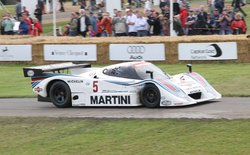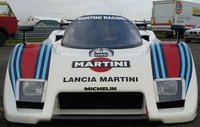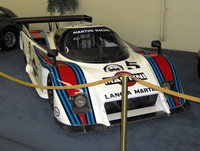Lancia LC2

The Lancia LC2 (sometimes referred to as a Lancia-Ferrari) was a racing car built by Lancia and using an engine built by Ferrari. It was part of Lancia's factory effort in the World Sportscar Championship from 1983 to 1986, although it continued to be used by privateer teams until 1991. It was also the company's first car meeting Group C regulations, replacing the previous LC1 which had run under Group 6 regulations.
Development
Having to meet the new Group C regulations, Lancia (under the direction of Cesare Fiorio) needed an all-new car to replace the open-cockpit LC1s that were no longer eligable for championship points. The Group C regulations required cars to meet certain fuel economy requirements, with teams given a set amount of fuel based on a race's distance. The previous turbocharged straight-4 Lancia engine from the LC1 was not capable of achieving the fuel economy necessary in Group C, requiring Lancia to seek a new powerplant.
Lancia lacked a production engine large enough to base a racing engine off of, leaving the company to turn to outside sources. Since Lancia was owned by the Fiat Group, they were able to seek the assistance of Ferrari. Ferrari allowed Lancia to adapt the new naturally-aspirated 3.0 litre 4-valve V8 which had been introduced in the Ferrari 308 GTBi QV in 1982. The engine was destroked to 2.65 litres to increase fuel economy, while two KKK turbochargers were added for power. The specific engine displacement was chosen because of the possible use of this same engine in the North American CART series.
For the car itself, design work was split between Abarth and Dallara, the later of which built the kevlar and carbon fiber monocoques in their factory. The LC2 featured a large intake for the radiators in the nose of the car just as the LC1 had, unlike the contemporary Porsche 956s which drew all their air from behind and to the sides of the cockpit. Inlets for the intercoolers were also intergrated onto the side bodywork of the car, immediately behind the doors. At the rear, a pontoon-style design was adapted, with the large wing bridging the gap and the rear diffusers exiting from below the car.
The LC2 was modified over its lifetime, with a multitude of modifications being made to the car's aerodynamics, including adapting brake duct inlets beneath the headlights. The Ferrari V8 was modified in 1984, bringing the displacement back up to 3.0 litres in an attempt to increase reliability and horsepower while improved engine electronics allowed the larger engine to use the same amount of fuel as the previous version.
Racing history
1983
The LC2s made their debut at the beginning of the 1983 season, being run under the Martini Racing name and painted in the Martini & Rossi colors, as well as using Italian Pirelli tires.[1] The first race of the season was also Lancia's home event, the 1000 km Monza. The LC2 proved more powerful than the 956s, taking the pole position by nearly a second over Joest Racing's 956. However tire problems took the leading Lancia out of the lead, and the second car lost twelve laps to the winning 956.
Tire problems and engine reliability hampered the LC2s all season, with neither car managing to finish a race again until the fifth round, the 1000 km Spa. There the two Martini Racing LC2s as well as the privateer Mirabella LC2 all finished, but only after suffering various difficulties that dropped them from contention earlier in the race. The LC2s finally saw reliability at the European Endurance Championship round at Brands Hatch, with Michele Alboreto and Riccardo Patrese finishing fourth. Lancia chose not to participate in the World Sportscar event in Japan, instead running the European Endurance event at Imola. The choice paid off as Teo Fabi and Hans Heyer earned the LC2 its first victory, although the factory Porsche team had not participated in this event. Lancia finished off the season with back-to-back second place finishes at Mugello and Kyalami. Even with their difficulties Lancia took second place in the World Constructors Championship, although they earned only 32 points to Porsche's 100.
1984
The evolved LC2s appeared once again at the 1000 km Monza to start the 1984 season, with revised suspension and new Dunlop tires. Lancia opened the season with a podium finish, followed by another pole position at Silverstone which earned a fourth place finish. For the 24 Hours of Le Mans, both cars qualified on the front row and led the early hours of the race, only for engine problems to lose the team their lead. Bob Wollek and Alessandro Nannini at least proved the reliability potential of the LC2, now equipped with its 3.0 litre engine, by finishing the full race in eighth position. The team took a brief hiatus after Brands Hatch, returning for Imola once again but they were unable to repeat their previous performance, both cars crashing out. Lancia once again skipped Fuji, returning for Kyalami where they took a 1-2 finish. Although the LC2 earned its second win ever, none of the major Porsche teams actually attended the event. Unable to challenge anymore for the Constructors or Drivers Championships, the team did not attend the final round of the year.
1985
1985 became a year in which Martini Racing needed to show the potential winning capabilities of the LC2 in order for Lancia to continue to fund a project that had seen limited success thus far. The car further evolved and now running Michelin tires, the season opened with an LC2 taking pole position at Mugello by 1.7 seconds ahead of the factory Porsche. Although the pole position car's engine did not last, the other team car managed to finish fourth. For the 1000 km Monza, the LC2s were nearly four seconds ahead of the closest Porsche in qualifying, and in fact led the race early on. However, while Patrese and Nannini were in third place and on the same lap as the leaders, a tree fell across the track and caused the race to be stopped early. On pole once again at Silverstone, the LC2s managed to remain with the leaders until the end when a wheel bearing failed, with Patrese and Nannini once again third and only two laps behind the winners. Although not able to take pole at Le Mans, and also unable to avoid reliability issues that took away their lead, the LC2s were at least able to finish the race in sixth and seventh places. A fuel pump failure also dropped the team out of contention at Hockenheimring.
The team finally managed to remain competitive throughout a race at Spa, with the LC2 of Wollek, Patrese, and Mauro Baldi leading the factory Porsche towards the end of the event. Race organisers chose to end the race at the time of the Lancia's lead, out of respect for driver Stefan Bellof who had been killed in an accident earlier in the event. Even with the shortened race, Lancia was able to celebrate their first victory over the factory Rothmans Porsche team. The following event, the 1000 km Brands Hatch, saw the LC2s leading en route to a potential win, only to hit one another and have to settle for third and fourth.[1] Once again unable to challenge Porsche in the championships, Lancia chose not to participate in the final two rounds. However they still managed to earn second in the Teams Championship, just ahead of the privateer Joest Racing Porsche.
1986
Seeing some remaining potential in the LC2, Lancia allowed the project to continue into 1986, but only as a one-car effort. The year opened with a sprint event at Monza, with the speed of the LC2 allowing it to take second place, less than a minute behind the winning Rothmans Porsche. The first endurance event at Silverstone however saw a return of the reliability problems that had trouble the LC2, as the fuel pump failed and the car was unable to finish. Feeling the cars were still not reliable enough nor fuel efficent enough to compete with the evolved Porsche 962C, Lancia determined that the project was no longer worth supporting, and Martini Racing pulled out of the championship. Lancia turned their full attention instead to their efforts in the World Rally Championship.
Privateers
Privateer teams intially attempted to carry on with older LC2 chassis. Gianni Mussato attempted two unsuccessful races in 1986 before leaving the championship, returning for one-off appearances in 1987 and 1988. The Mussato car moved to Dollop Racing later in 1988, where it too was unsuccessful and failed to finish any of the races that season. Mussato returned in 1989 with a newly built LC2, but once again the car struggled to finish any races during the season. His team made a final attempt in 1990, running just the 24 Hours of Le Mans, but the outcome was the usual. Even into 1991, the Veneto Equipe team turned to the LC2 to contend the World Sportscar Championship. As with all previous privateer efforts the car was unable to compete, failing to even qualify for some of the races, let alone finish them.
External links
- World Sports Racing Prototypes - Lancia Chassis Numbers
| LANCIA | ||||||||||||||||||||||
|---|---|---|---|---|---|---|---|---|---|---|---|---|---|---|---|---|---|---|---|---|---|---|
|
1907-1918: Alfa-12HP · Alfa-24HP · Dialfa-18HP · Beta-15/20HP · Delta-20/30HP · Epsilon · Eta-30/50HP · Gamma-20HP · Theta-35HP · Zeta-12/15HP
| ||||||||||||||||||||||
| Vincenzo Lancia · Corporate website · A brand of the Fiat group | ||||||||||||||||||||||

